Dynamics of Aromia bungii (Faldermann, 1835) (Coleoptera, Cerambycidae) Distribution in China Amidst Climate Change: Dual Insights from MaxEnt and Meta-Analysis
Abstract
1. Introduction
2. Materials and Methods
2.1. Species Occurrence Data
2.2. Environmental Variables and Data Processing
2.3. Modeling Process and Statistical Analysis
2.4. Model Evaluation
2.5. Meta-Analysis
2.5.1. Data Collection and Processing
2.5.2. Data Analysis
3. Results
3.1. Survival Response to Altitude
3.2. Model Performance and Accuracy Assessment
3.3. Selection of Key Environmental Factors
3.4. Potential Distribution of A. bungii in the Current Period in China
3.5. Potential Distribution of A. bungii in Future Periods in China
3.6. Primary Climatic Variables Influencing Distribution of A. bungii
3.7. Changes in Centroid of Potential Distribution
4. Discussion
4.1. Predictive Capabilities of the MaxEnt Model
4.2. Key Environmental Factors Influencing the Distribution of A. bungii
4.3. Future Distribution Changes for A. bungii
4.4. Limitations of This Study
5. Conclusions
Author Contributions
Funding
Institutional Review Board Statement
Data Availability Statement
Conflicts of Interest
References
- Ma, A.; Yang, X.; Liu, W.; Lu, Z.; Li, J.; Ran, H. The occurrence and green control technology of Aromia bungii Faldermann adults. China Plant Prot. 2023, 43, 54–59. [Google Scholar]
- Zhang, L.; Wang, P.; Xie, G.; Wang, W. Spatial distribution pattern of Aromia bungii within china and its potential distribution under climate change and human activity. Ecol. Evol. 2024, 14, e70520. [Google Scholar] [CrossRef] [PubMed]
- Bai, R.; Wang, Y.; Ma, Z.; Jia, Y.; Lv, D. Advance in research of Aromia bungii Faldermann. For. Pest Dis. 2017, 36, 5–9. [Google Scholar]
- Gong, Q.; Huang, A.; Tang, Y.; Xiong, J. Summary of IPM of Aromia bungii Faldermann. Biol. Disaster Sci. 2013, 36, 430–433. [Google Scholar]
- Han, M.; Ma, A.; Lu, Z.; Liu, W.; Li, J.; Ran, H. Research Progress of Occurrence, Damage and Control Technology of Aromia bungii Faldermann. J. Hebei Agric. Sci. 2019, 23, 47–50. [Google Scholar]
- Zhang, Y.; Wang, R.; Yu, Y.; Luo, Y. Damage and population dynamics of wood-boring Cerambycid beetles in Rosaceous fruit trees. Chin. J. Appl. Entomol. 2017, 54, 500–505. [Google Scholar]
- Xu, T.; Yasui, H.; Teale, S.A.; Fujiwara-Tsujii, N.; Wickham, J.D.; Fukaya, M.; Hansen, L.; Kiriyama, S.; Hao, D.; Nakano, A.; et al. Identification of a male-produced sex-aggregation pheromone for a highly invasive cerambycid beetle, Aromia bungii. Sci. Rep. 2017, 7, 7330. [Google Scholar] [CrossRef]
- Qu, Z.; Huang, Y.; Zhao, H.; Chen, Z.; Pan, T.; Hao, C.; Gao, S. Study on the Control of Aromia bungii Fald by the Combined Release of Adult and Egg of Dastarcus helophoroides (Fairmaire). J. Shandong Agric. Univ. (Nat. Sci. Ed.) 2022, 53, 863–867. [Google Scholar]
- Han, M. Research on Occurrence, Damage and Control Technology of the Aromia bungii Faldermann. Master’s Thesis, Hebei Agricultural University, Baoding, China, 2019. [Google Scholar]
- Yamamoto, Y.; Kaneko, S. Seasonal Prevalence of the Invasive Longhorn Beetle Aromia bungii in Osaka Prefecture, Japan. Insects 2022, 13, 222. [Google Scholar] [CrossRef]
- Wang, J. Study on Host Search Mechanism of Two Natural Enemies of Aromia gungii Using Kairomone and Their Joint Bio-control Effect. Master’s Thesis, Hebei University, Baoding, China, 2022. [Google Scholar]
- Chen, J.; Yan, S.; Cao, D.; Jing, J.; Zhang, K.; Jian, K.; Ma, H.; Wei, J. Mating behavior of Aromia bungii (Coleoptera: Cerambycidae) adults and their perching and oviposition preference on different host plants. Acta Entomol. Sin. 2020, 63, 851–860. [Google Scholar]
- Wu, Z. Identification and Expression Profile of Chemosensory Genes in Aromia bungii (Faldermann) Antennal Transcriptome. Master’s Thesis, Anhui Agricultural University, Hefei, China, 2022. [Google Scholar]
- Zhao, W.; Xie, G.; Wang, W. Ultrastructure of sensilla on the antennae, mouthparts and tarsi of Aromia bungii (Cerambycidae: Cerambycinae). J. Environ. Entomol. 2023, 46, 1–22. [Google Scholar]
- Li, R.; Song, X.; Du, Y. Mitochondrial genome of Aromia bungii (Coleoptera: Chrysomeloidea: Cerambycidae) and phylogenetic analysis. Mitochondrial DNA Part B 2021, 6, 71–72. [Google Scholar] [CrossRef]
- Sunamura, E.; Tamura, S.; Taki, H.; Buczkowski, G.; Shoda-Kagaya, E. Effects of neonicotinoid insecticide trunk injections on non-target arboreal ants, potential biological control agents for invasive longhorn beetle Aromia bungii on cherry trees. Appl. Entomol. Zoolog. 2023, 58, 401–407. [Google Scholar] [CrossRef]
- Zou, Y.; Hansen, L.; Xu, T.; Teale, S.A.; Hao, D.; Millar, J.G. Optimizing pheromone-based lures for the invasive red-necked longhorn beetle, Aromia bungii. J. Pest Sci. 2019, 92, 1217–1225. [Google Scholar] [CrossRef]
- Elith, J.; Leathwick, J.R. Species Distribution Models: Ecological Explanation and Prediction Across Space and Time. Annu. Rev. Ecol. Evol. Syst. 2009, 40, 677–697. [Google Scholar] [CrossRef]
- Phillips, S.J.; Anderson, R.P.; Schapire, R.E. Maximum entropy modeling of species geographic distributions. Ecol. Model. 2006, 190, 231–259. [Google Scholar] [CrossRef]
- Byeon, D.; Jung, S.; Lee, W. Review of CLIMEX and MaxEnt for studying species distribution in South Korea. J. Asia-Pac. Biodivers. 2018, 11, 325–333. [Google Scholar] [CrossRef]
- Kumar, S.; Neven, L.G.; Zhu, H.; Zhang, R. Assessing the Global Risk of Establishment of Cydia pomonella (Lepidoptera: Tortricidae) using CLIMEX and MaxEnt Niche Models. J. Econ. Entomol. 2015, 108, 1708–1719. [Google Scholar] [CrossRef]
- Fuller, D.O.; Ahumada, M.L.; Quiñones, M.L.; Herrera, S.; Beier, J.C. Near-present and future distribution of Anopheles albimanus in Mesoamerica and the Caribbean Basin modeled with climate and topographic data. Int. J. Health Geogr. 2012, 11, 13. [Google Scholar] [CrossRef]
- Wang, X.; Duan, Y.; Jin, L.; Wang, C.; Peng, M.; Li, Y.; Wang, X.; Ma, Y. Prediction of historical, present and future distribution of Quercus sect. Heterobalanus based on the optimized MaxEnt model in China. Acta Ecol. Sin. 2023, 43, 6590–6604. [Google Scholar]
- Lehrer, E.J.; Wang, M.; Sun, Y.; Zaorsky, N.G. An Introduction to Meta-Analysis. Int. J. Radiat. Oncol. Biol. Phys. 2023, 115, 564–571. [Google Scholar] [CrossRef]
- Santana, P.A.; Kumar, L.; Silva, R.S.; Picanço, M.C. Global geographic distribution of Tuta absoluta as affected by climate change. J. Pest Sci. 2019, 92, 1373–1385. [Google Scholar] [CrossRef]
- Gao, R.; Liu, L.; Li, R.; Fan, S.; Dong, J.; Zhao, L. Predicting potential distributions of Monochamus saltuarius, a novel insect vector of pine wilt disease in China. Front. For. Glob. Change 2023, 6, 1243996. [Google Scholar] [CrossRef]
- Pan, S.; Peng, D.; Li, Y.; Chen, Z.; Zhai, Y.; Liu, C.; Hong, B. Potential global distribution of the guava root-knot nematode Meloidogyne enterolobii under different climate change scenarios using MaxEnt ecological niche modeling. J. Integr. Agric. 2023, 22, 2138–2150. [Google Scholar] [CrossRef]
- Xian, X.; Zhao, H.; Guo, J.; Zhang, G.; Liu, H.; Liu, W.; Fanghao, W. Estimation of the potential geographical distribution of a new potato pest (Schrankia costaestrigalis) in China under climate change. J. Integr. Agric. 2023, 22, 2441–2455. [Google Scholar] [CrossRef]
- Wu, T.; Lu, Y.; Fang, Y.; Xin, X.; Li, L.; Li, W.; Jie, W.; Zhang, J.; Liu, Y.; Zhang, L.; et al. The Beijing Climate Center Climate System Model (BCC-CSM): The main progress from CMIP5 to CMIP6. Geosci. Model Dev. 2019, 12, 1573–1600. [Google Scholar] [CrossRef]
- Xu, D.; Zhuo, Z.; Wang, R.; Ye, M.; Pu, B. Modeling the distribution of Zanthoxylum armatum in China with MaxEnt modeling. Glob. Ecol. Conserv. 2019, 19, e00691. [Google Scholar] [CrossRef]
- Wei, X.; Xu, D.; Liu, Q.; Wu, Y.; Zhuo, Z. Predicting the potential distribution range of Batocera horsfieldi under CMIP6 climate change using the MaxEnt model. J. Econ. Entomol. 2024, 117, 187–198. [Google Scholar] [CrossRef]
- Li, Y.; Li, M.; Li, C.; Liu, Z. Optimized Maxent Model Predictions of Climate Change Impacts on the Suitable Distribution of Cunninghamia lanceolata in China. Forests 2020, 11, 302. [Google Scholar] [CrossRef]
- Chen, X.; Lei, Y.; Zhang, X.; Jia, H. Effects of Sample Sizes on Accuracy and Stability of Maximum Entropy Model in Predicting Species Distribution. Sci. Silvae Sin. 2012, 48, 53–59. [Google Scholar]
- Wang, R.; Li, Q.; Feng, C.; Shi, Z. Predicting potential ecological distribution of Locusta migratoria tibetensis in China using MaxEnt ecological niche modeling. Acta Ecol. Sin. 2017, 37, 8556–8566. [Google Scholar]
- Radosavljevic, A.; Anderson, R.P. Making better MAXENT models of species distributions: Complexity, overfitting and evaluation. J. Biogeogr. 2014, 41, 629–643. [Google Scholar] [CrossRef]
- Phillips, S.J.; Anderson, R.P.; Dudik, M.; Schapire, R.E.; Blair, M.E. Opening the black box: An open-source release of Maxent. Ecography 2017, 40, 887–893. [Google Scholar] [CrossRef]
- Zhao, G.; Cui, X.; Sun, J.; Li, T.; Wang, Q.; Ye, X.; Fan, B. Analysis of the distribution pattern of Chinese Ziziphus jujuba under climate change based on optimized biomod2 and MaxEnt models. Ecol. Indic. 2021, 132, 108256. [Google Scholar] [CrossRef]
- Zhang, H.; Xu, D.; Deng, X.; Liu, Z.; He, Z.; Wu, J.; Zhuo, Z. Impact of temperature variation on the biological traits and lifecycle of spodoptera exigua (lepidoptera: Noctuidae): A meta-analysis approach. Insects 2025, 16, 155. [Google Scholar] [CrossRef]
- Bale, J.S.; Masters, G.J.; Hodkinson, I.D.; Awmack, C.; Bezemer, T.M.; Brown, V.K.; Butterfield, J.; Buse, A.; Coulson, J.C.; Farrar, J.; et al. Herbivory in global climate change research: Direct effects of rising temperature on insect herbivores. Glob. Change Biol. 2002, 8, 1–16. [Google Scholar] [CrossRef]
- Kocmánková, E.; Trnka, M.; Juroch, J.; Dubrovský, M.; Semerádová, D.; Možný, M.; Žalud, Z. Impact of climate change on the occurrence and activity of harmful organisms. Plant Prot. Sci. 2009, 45, S48–S52. [Google Scholar] [CrossRef]
- Cao, D.; Liu, J.; Zhao, Z.; Yan, X.; Wang, W.; Wei, J. Chemical Compounds Emitted from Mentha spicata Repel Aromia bungii Females. Insects 2022, 13, 244. [Google Scholar] [CrossRef]
- Wang, J.; Wang, F.; Wang, R.; Zhang, J.; Zhao, X.; Yang, H.; Yang, W.; Yang, C.; Wang, Z.; Li, A. Modeling the effects of bioclimatic characteristics and distribution on the occurrence of Cyrtotrachelus buqueti in the Sichuan Basin. Glob. Ecol. Conserv. 2019, 17, e00540. [Google Scholar] [CrossRef]
- Qiu, X.; Xu, Y.; Chu, S.; Song, Y. Effect of Dastarcus helophoroides control on Aromia bungii and its relationship with meteorological factors. South China Fruits 2019, 48, 107–110. [Google Scholar]
- Hlávková, D.; Doležal, P. Cambioxylophagous pests of scots pine: Ecological physiology of european populations—A review. Front. For. Glob. Change 2022, 5, 864651. [Google Scholar] [CrossRef]
- Qi, J.; Nan, J.; Zhao, X.; Liang, C.; Fan, J.; He, H. Genetic structure of monochamus alternatus (hope) in qinling-daba mountains and expansion trend: Implications for pest prevention and management. Ecol. Evol. 2024, 14, e70373. [Google Scholar] [CrossRef] [PubMed]
- Xu, D.; Zhuo, Z.; Li, X.; Wang, R. Distribution and invasion risk assessment of Oryctes rhinoceros (L.) in China under changing climate. J. Appl. Entomol. 2022, 146, 385–395. [Google Scholar] [CrossRef]
- Qin, S.; Yan, Y.; Ouyang, S. Prediction of the potential distribution of Chimonanthus praecox in China based on MAXENT model and Arc GIS. Ecol. Sci. 2020, 39, 49–56. [Google Scholar]
- Li, G.; Liu, C.; Liu, Y.; Yang, J.; Zhang, X.; Guo, K. Advances in theoretical issues of species distribution models. Acta Ecol. Sin. 2013, 33, 4827–4835. [Google Scholar]
- Karmezi, M.; Bataka, A.; Papachristos, D.; Avtzis, D.N. Nematodes in the pine forests of northern and central greece. Insects 2022, 13, 194. [Google Scholar] [CrossRef]

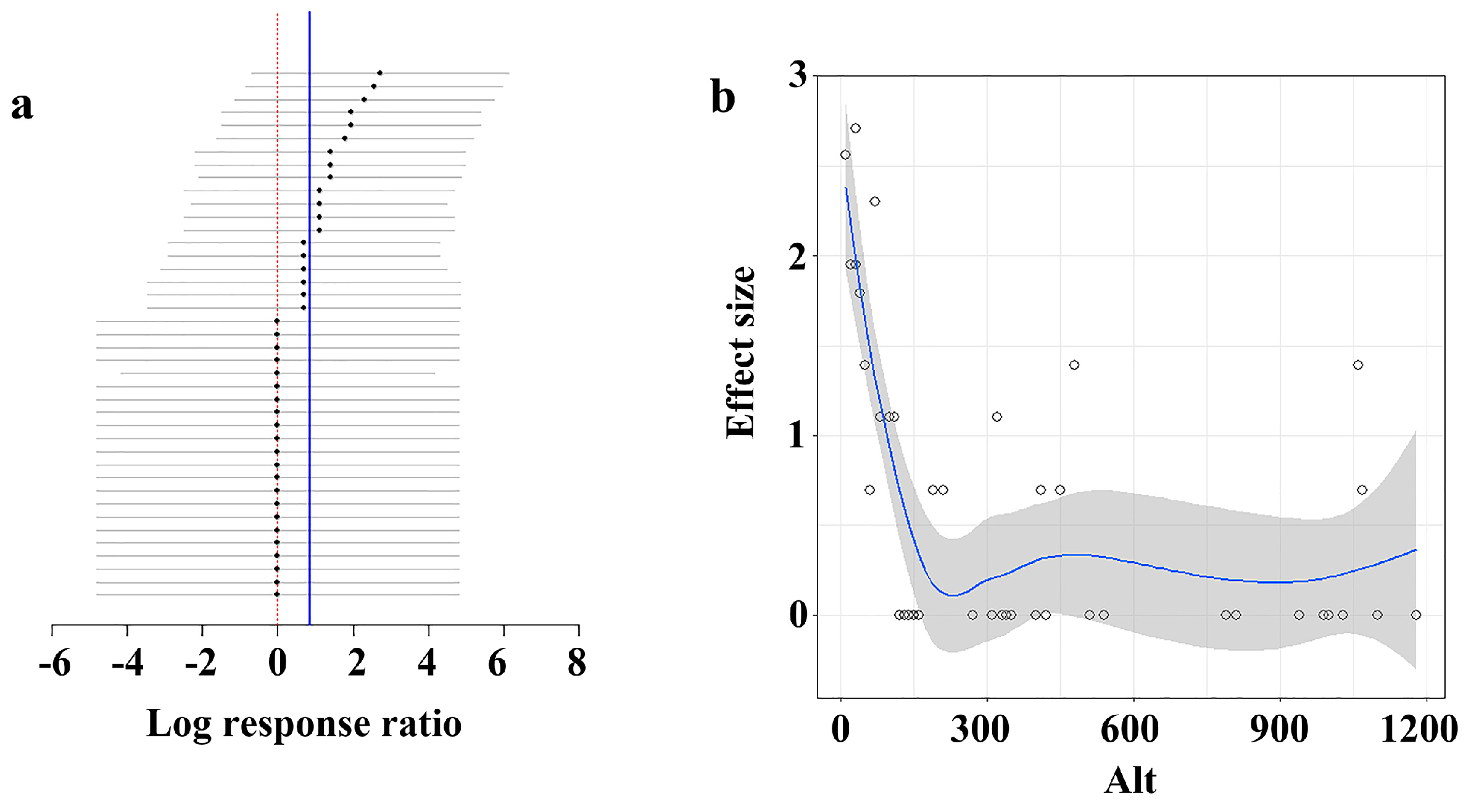
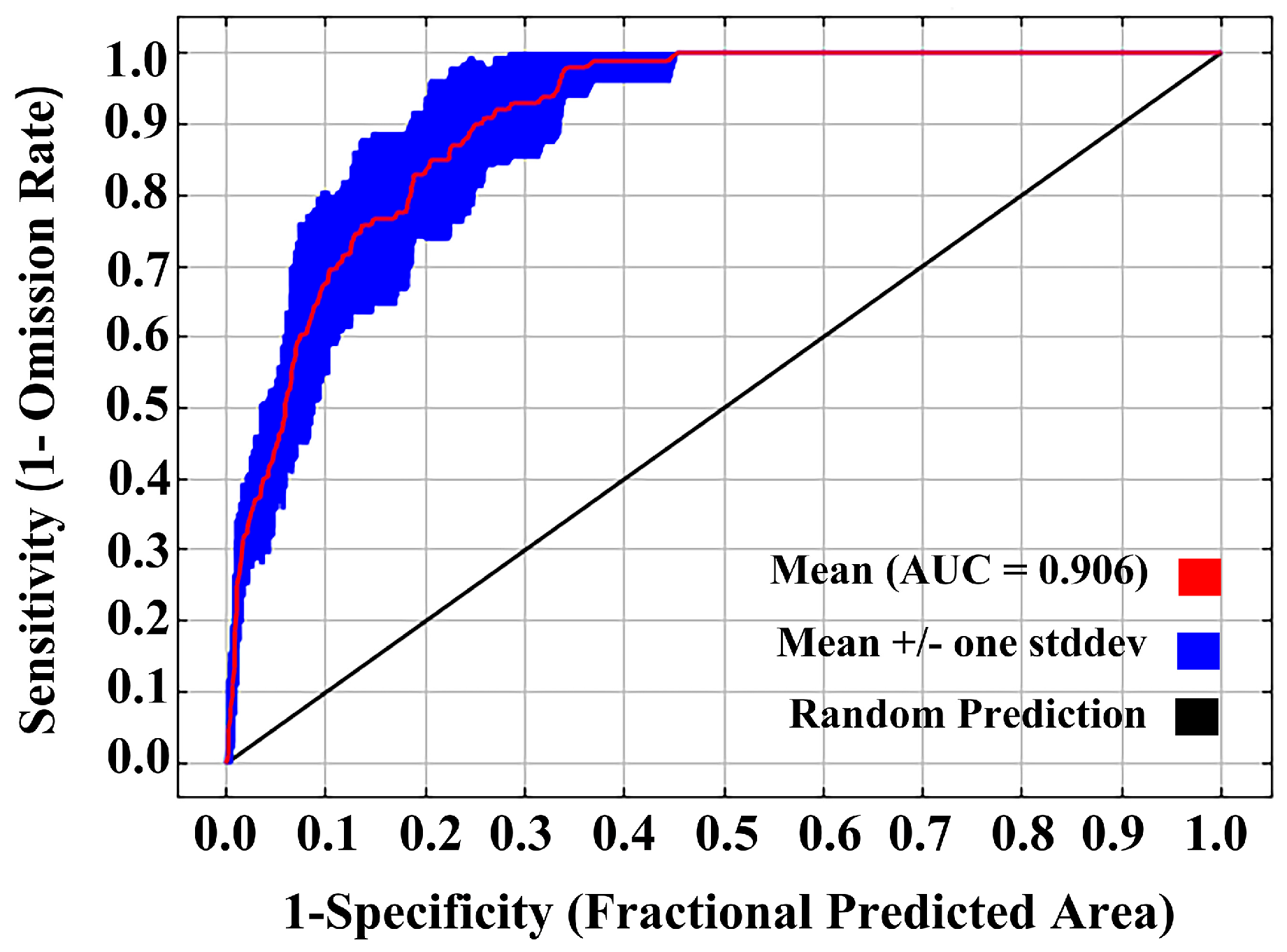
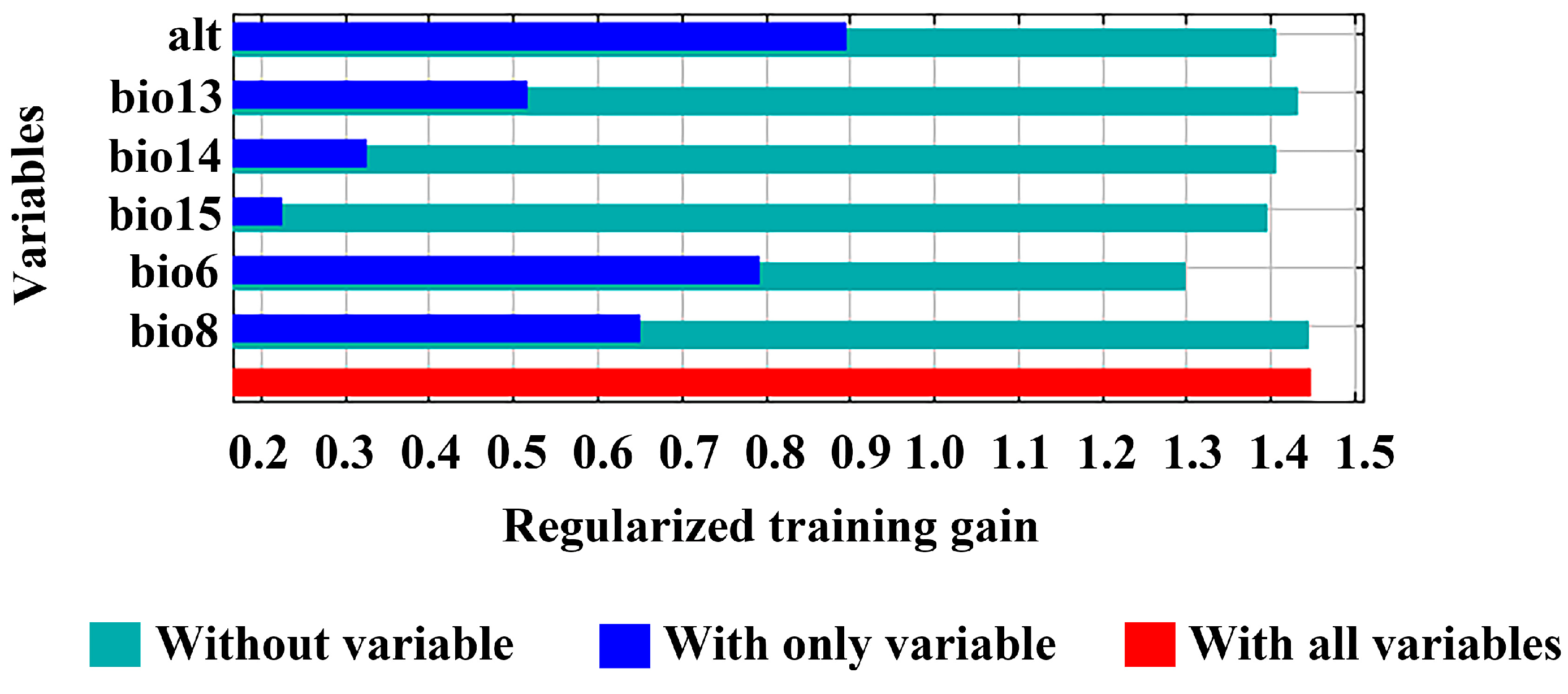
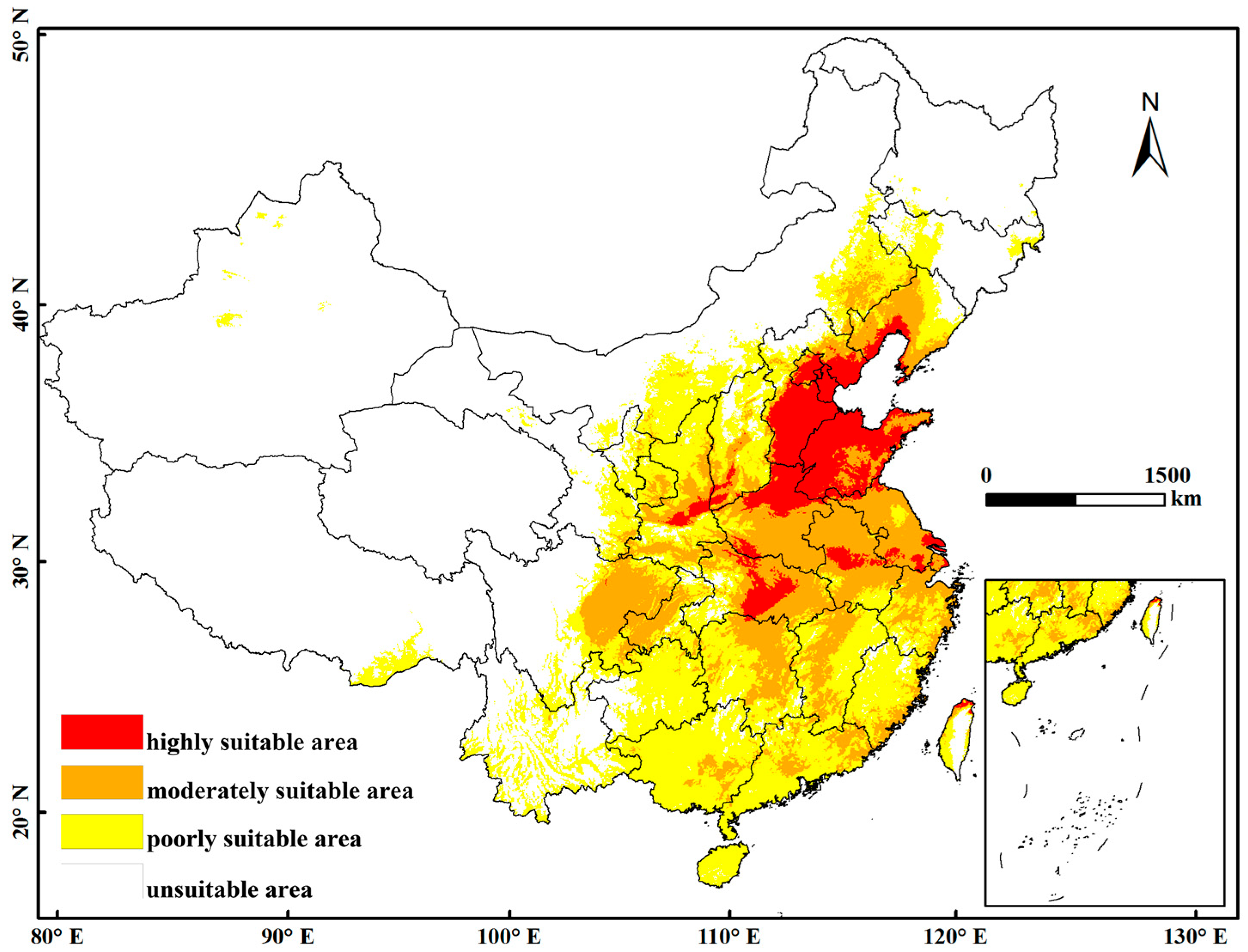
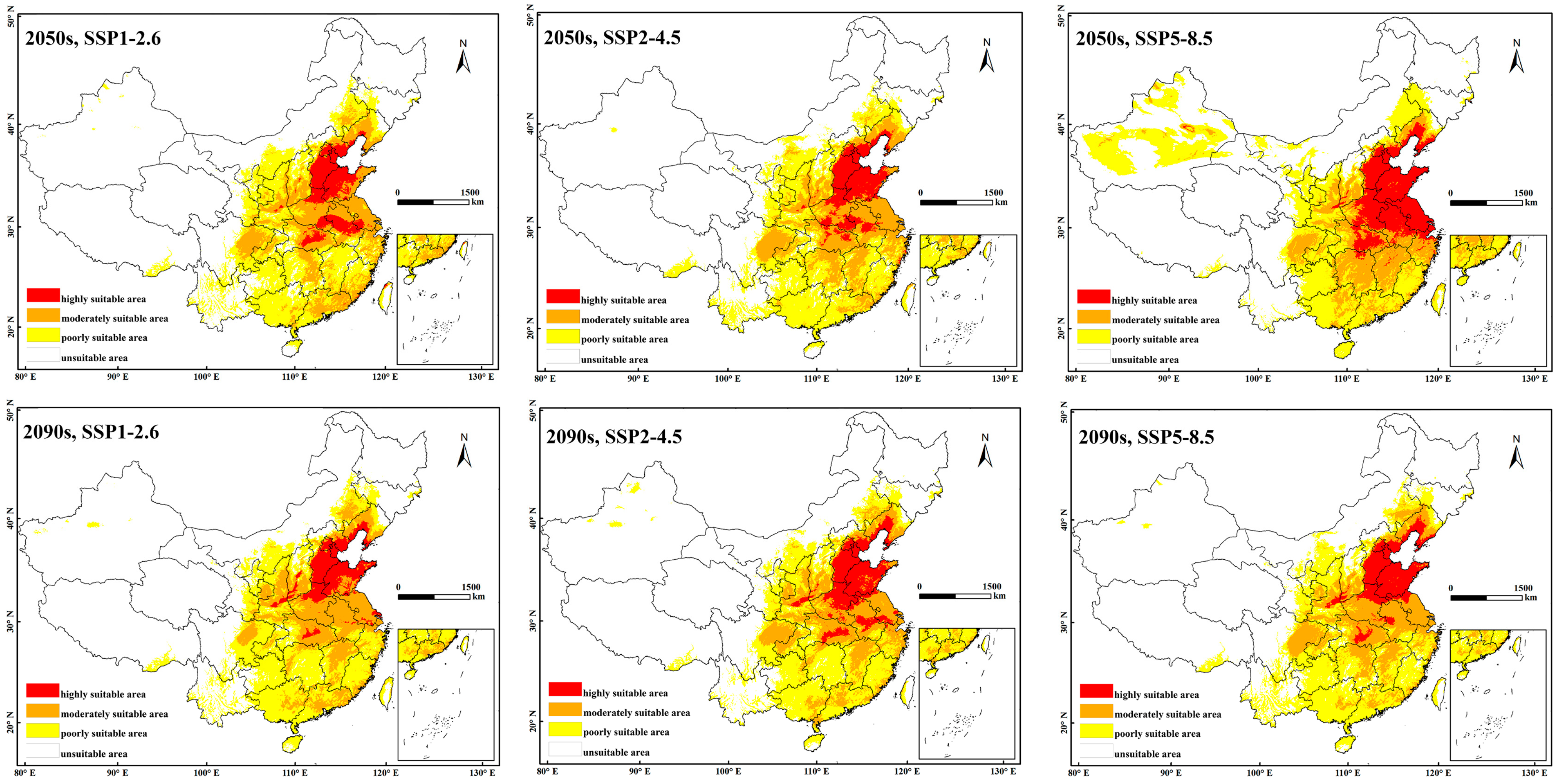

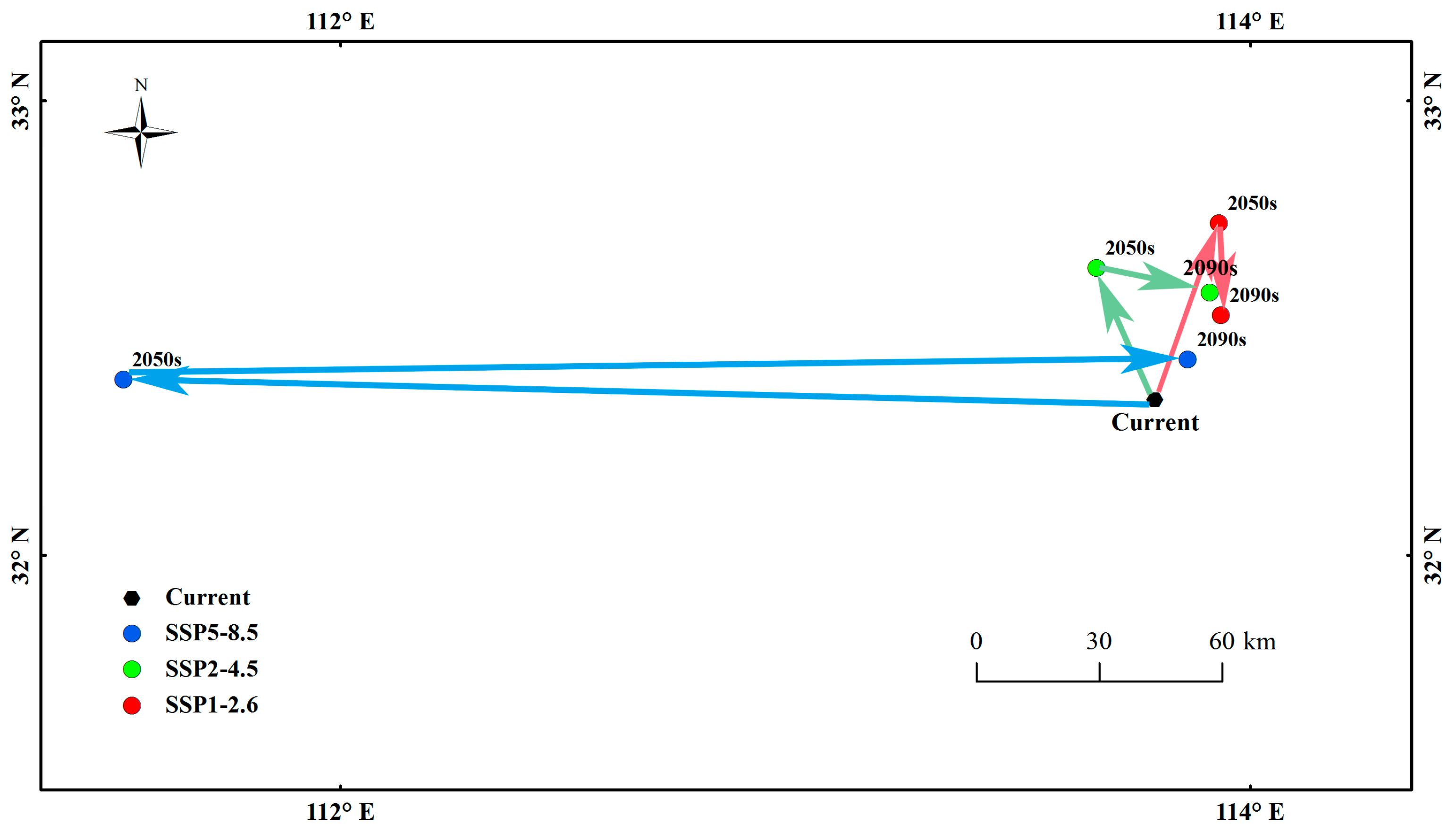

| bio6 | bio8 | bio13 | bio14 | |
|---|---|---|---|---|
| bio8 | −0.046 | |||
| bio13 | 0.402 ** | 0.659 ** | ||
| bio14 | 0.694 ** | 0.253 ** | 0.559 ** | |
| bio15 | −0.686 ** | 0.570 ** | 0.229 * | −0.492 ** |
| Variable | Environmental Variable | Unit |
|---|---|---|
| Bio6 | Minimum Temperature of the Coldest Month | °C |
| Bio8 | Mean Temperature of the Wettest Quarter | °C |
| Bio13 | Precipitation of the Wettest Month | mm |
| Bio14 | Precipitation of the Driest Month | mm |
| Bio15 | Precipitation Seasonality (Coefficient of Variation) | unitless |
| Alt | Altitude | m |
| Variable | Percent Contribution (%) | Permutation Importance (%) |
|---|---|---|
| Alt | 43.6 | 33.1 |
| Bio6 | 25.7 | 43.5 |
| Bio15 | 13.3 | 5 |
| Bio13 | 9.9 | 3.8 |
| Bio14 | 6.9 | 14.4 |
| Bio8 | 0.7 | 0.2 |
| Province | Highly Suitable Area (104 km2) | Total (104 km2) * | Percentage of Highly Suitable Area in Province (%) | Percentage of Highly Suitable Area in China (%) |
|---|---|---|---|---|
| Liaoning | 1.95 | 14.80 | 13.17 | 4.71 |
| Hebei | 10.26 | 18.88 | 54.32 | 24.76 |
| Beijing | 1.14 | 1.64 | 69.55 | 2.75 |
| Shanxi | 0.77 | 15.67 | 4.90 | 1.85 |
| Tianjin | 1.22 | 1.20 | 101.85 | 2.95 |
| Shaanxi | 1.26 | 15.67 | 8.07 | 3.05 |
| Shandong | 12.40 | 15.80 | 78.47 | 29.93 |
| Henan | 5.30 | 16.70 | 31.72 | 12.79 |
| Jiangsu | 1.74 | 10.72 | 16.23 | 4.20 |
| Anhui | 1.43 | 14.01 | 10.21 | 3.45 |
| Sichuan | 0.01 | 48.60 | 0.03 | 0.03 |
| Hubei | 3.37 | 18.59 | 18.15 | 8.14 |
| Shanghai | 0.23 | 0.63 | 36.93 | 0.56 |
| Zhejiang | 0.07 | 10.60 | 0.62 | 0.16 |
| Hunan | 0.08 | 21.18 | 0.38 | 0.19 |
| Fujian | 0.01 | 12.40 | 0.10 | 0.03 |
| Taiwan | 0.19 | 3.60 | 5.16 | 0.45 |
| China | 41.43 | / | / | 4.30 |
| Decade and Scenario | Predicted Area (104 km2) | Comparison with Current Distribution (%) | ||||||
|---|---|---|---|---|---|---|---|---|
| Poorly Suitable Area | Moderately Suitable Area | Highly Suitable Area | Total Suitable Habitat | Poorly Suitable Area | Moderately Suitable Area | Highly Suitable Area | Total Suitable Habitat | |
| Current | 174.72 | 104.53 | 41.43 | 320.68 | ||||
| 2050s, SSP1-2.6 | 171.83 | 100.99 | 38.57 | 311.39 | −1.65 | −3.39 | −6.90 | −2.90 |
| 2090s, SSP1-2.6 | 179.06 | 105.22 | 37.71 | 321.99 | 2.48 | 0.66 | −8.98 | 0.41 |
| 2050s, SSP2-4.5 | 173.05 | 103.44 | 42.58 | 319.07 | −0.96 | −1.04 | 2.78 | −0.50 |
| 2090s, SSP2-4.5 | 168.13 | 100.70 | 49.76 | 318.59 | −3.77 | −3.66 | 20.11 | −0.65 |
| 2050s, SSP5-8.5 | 214.18 | 93.69 | 74.11 | 381.98 | 22.58 | −10.37 | 78.88 | 19.12 |
| 2090s, SSP5-8.5 | 174.06 | 103.11 | 44.65 | 321.82 | −0.38 | −1.36 | 7.77 | 0.36 |
Disclaimer/Publisher’s Note: The statements, opinions and data contained in all publications are solely those of the individual author(s) and contributor(s) and not of MDPI and/or the editor(s). MDPI and/or the editor(s) disclaim responsibility for any injury to people or property resulting from any ideas, methods, instructions or products referred to in the content. |
© 2025 by the authors. Licensee MDPI, Basel, Switzerland. This article is an open access article distributed under the terms and conditions of the Creative Commons Attribution (CC BY) license (https://creativecommons.org/licenses/by/4.0/).
Share and Cite
He, Z.; Wei, X.; Li, Y.; Deng, X.; Zhuo, Z. Dynamics of Aromia bungii (Faldermann, 1835) (Coleoptera, Cerambycidae) Distribution in China Amidst Climate Change: Dual Insights from MaxEnt and Meta-Analysis. Agriculture 2025, 15, 1224. https://doi.org/10.3390/agriculture15111224
He Z, Wei X, Li Y, Deng X, Zhuo Z. Dynamics of Aromia bungii (Faldermann, 1835) (Coleoptera, Cerambycidae) Distribution in China Amidst Climate Change: Dual Insights from MaxEnt and Meta-Analysis. Agriculture. 2025; 15(11):1224. https://doi.org/10.3390/agriculture15111224
Chicago/Turabian StyleHe, Zhipeng, Xinju Wei, Yaping Li, Xinqi Deng, and Zhihang Zhuo. 2025. "Dynamics of Aromia bungii (Faldermann, 1835) (Coleoptera, Cerambycidae) Distribution in China Amidst Climate Change: Dual Insights from MaxEnt and Meta-Analysis" Agriculture 15, no. 11: 1224. https://doi.org/10.3390/agriculture15111224
APA StyleHe, Z., Wei, X., Li, Y., Deng, X., & Zhuo, Z. (2025). Dynamics of Aromia bungii (Faldermann, 1835) (Coleoptera, Cerambycidae) Distribution in China Amidst Climate Change: Dual Insights from MaxEnt and Meta-Analysis. Agriculture, 15(11), 1224. https://doi.org/10.3390/agriculture15111224






